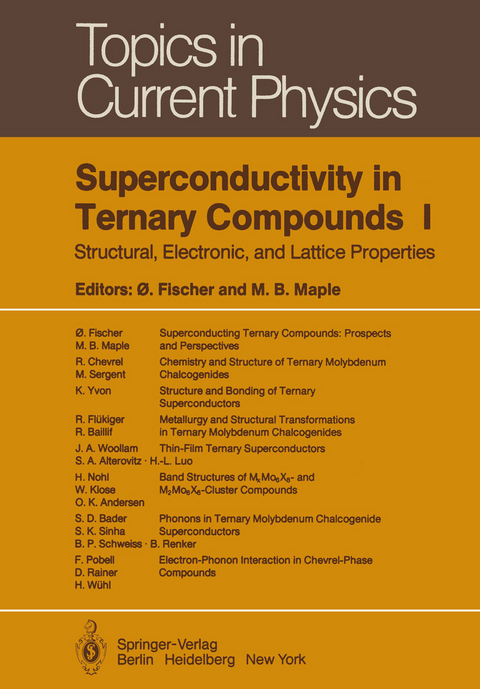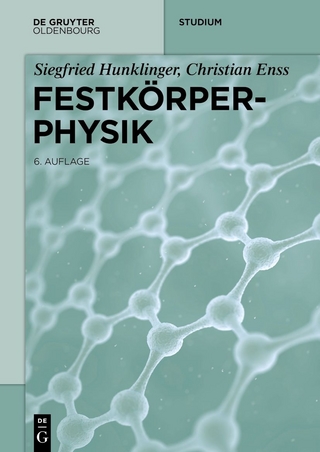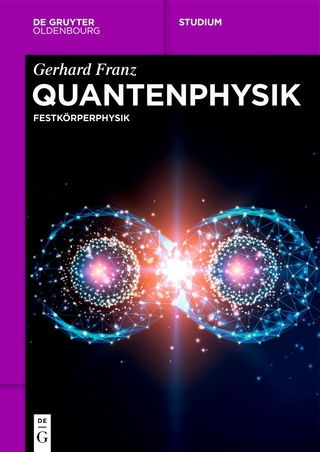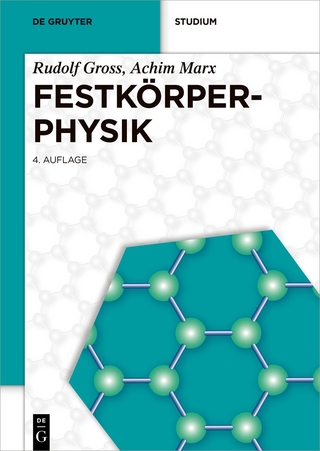
Superconductivity in Ternary Compounds I
Springer Berlin (Verlag)
978-3-642-81870-7 (ISBN)
The structural. electronic and lattice properties of superconducting ternary com pounds are the subject of this Topics volume. Its companion volume (Topics in Cur rent Physics. Volume 34) deals primarily with the mutual interaction of supercon ductivity and magnetism in ternary compounds. These two volumes are the culmination of a project. started nearly two years ago. that was inspired by the intense re search effort. both experimental and theoretical. then being expended to explore and develop an understanding of the remarkable physical properties of ternary super conductors. Research activity on this subject has increased in the meantime. The interest in ternary superconductors originated in 1972. when B.T. Matthias and his co-workers first discovered superconductivity in several ternary molybdenum sulfide compounds that had been synthesized in 1971 by R. Chevrel. M. Sergent. and J. Prigent. The superconducting critical temperature Tc of one of the compounds. PbMo S - was reported to be ~ 15 K. This value is sufficiently high that there was g 6 (and still is) reason to expect that other ternary compounds would be found with superconducting transition temperatures rivaling those of the A15 compounds. of which Nb Ge has the record high Tc of 23 K. The interest in ternary superconductors 3 received further impetus when several of the ternary molybdenum sulfides were found to have exceptionally high upper critical magnetic fields. some of them in the neighborhood of 50 Tesla or more. An immense amount of research on ternary molybdenum chalcogenides then followed.
1. Superconducting Ternary Compounds: Prospects and Perspectives.- 1.1 Introduction.- 1.2 The Ternary Materials.- 1.3 Concluding Remarks.- References.- 2. Chemistry and Structure of Ternary Molybdenum Chalcogenides.- 2.1 Overview.- 2.2 Preparation and Characterization.- 2.3 Crystal Structure.- 2.4 Relations Between Structure and Properties.- 2.5 New Ternary Compounds Resulting from Linear Condensation of the Octahedral Mo6 Clusters.- 2.6 Conclusion.- Appendix: Tables.- References.- 3. Structure and Bonding of Ternary Superconductors.- 3.1 Introductory Comments.- 3.2 Ternary Molybdenum Chalcogenides MMo6X8 (M: Metal, X: Chalcogen).- 3.3 Ternary Molybdenum Chalcogenides Built Up by Condensed Mo3nX3n+2 Units (X = S, Se, Te).- 3.4 Ternary Borides MT4B4 (M: Metal, T: Transition Element).- References.- 4. Metallurgy and Structural Transformations in Ternary Molybdenum Chalcogenides.- 4.1 Preparation Methods and Stoichiometry.- 4.2 High-Temperature Phase Fields in Some Selected Systems.- 4.3 Low-Temperature Relationships in CuxMo6S8 and CuxMo6Se8.- 4.4 The Type of Formation of the Triclinic Phase in Ternary Molybdenum Chalcogenides.- 4.5 Mechanism of Structural Transformations in Ternary Molybdenum Chalcogenides.- 4.6 Superconductivity and Structural Transformations in Ternary Rhombohedral Compounds.- References.- 5. Thin-Film Ternary Superconductors.- 5.1 Preliminary Comments.- 5.2 Preparation and Structure.- 5.3 Critical Fields.- 5.4 Critical Currents.- 5.5 Electronic Properties.- 5.6 Final Statements and Conclusions.- References.- 6. Band Structures of MxMo6X8 - and M2Mo6X6-Cluster Compounds.- 6.1 General Considerations.- 6.2 Input to the Band-Structure Calculations.- 6.3 One-Electron States of a Single Mo6X8 Cluster.- 6.4 Energy Bands of Chevrel Phases.- 6.5 Energy Bandsof Chain Compounds.- References.- 7. Phonons in Ternary Molybdenum Chalcogenide Superconductors.- 7.1 Preliminary Comments.- 7.2 The Molecular-Crystal Model and Lattice Heat Capacity.- 7.3 Phonon Spectra from Inelastic Neutron Scattering.- 7.4 A Simple Force-Constant Model for the Lattice Dynamics of Chevrel-Phase Compounds.- 7.5 Inelastic Neutron Scattering Experiments on Single Crystals.- 7.6 Relationship of the Phonon Spectrum to the Electron-Phonon Interaction.- 7.7 Summary.- References.- 8. Electron-Phonon Interaction in Chevrel-Phase Compounds.- 8.1 Introductory Remarks.- 8.2 Experiments on the Electron-Phonon Coupling.- 8.3 Theoretical Models for the Electron-Phonon Coupling.- 8.4 Isotope Effect of Tc in Mo6Se8 and SnMo6S8.- 8.5 Tunneling Spectroscopy on Cu1.8Mo6S8 and PbMo6S8.- 8.6 Conclusion.- References.
| Erscheint lt. Verlag | 5.12.2011 |
|---|---|
| Reihe/Serie | Topics in Current Physics |
| Zusatzinfo | XVI, 286 p. |
| Verlagsort | Berlin |
| Sprache | englisch |
| Maße | 170 x 244 mm |
| Gewicht | 534 g |
| Themenwelt | Naturwissenschaften ► Physik / Astronomie ► Festkörperphysik |
| Technik ► Elektrotechnik / Energietechnik | |
| Technik ► Maschinenbau | |
| Schlagworte | band structure • Chemistry • Crystal • crystal structure • Dispersion • Fischer • lattice dynamics • magnetic fields • magnetism • Mössbauer effect • neutron diffraction • scattering • Superconductivity • Superconductor • Temperature • Ternäre Molybdänchalcogenide |
| ISBN-10 | 3-642-81870-6 / 3642818706 |
| ISBN-13 | 978-3-642-81870-7 / 9783642818707 |
| Zustand | Neuware |
| Haben Sie eine Frage zum Produkt? |
aus dem Bereich


